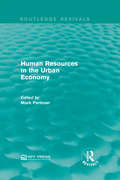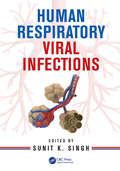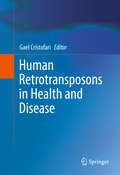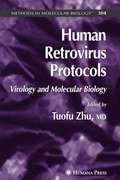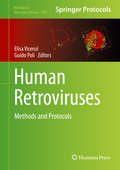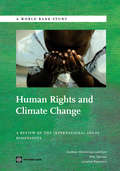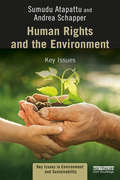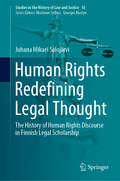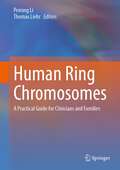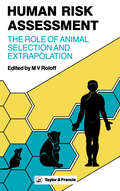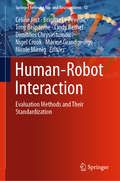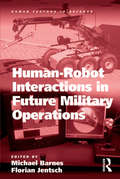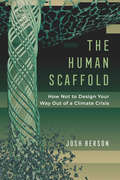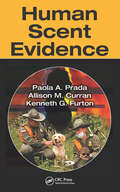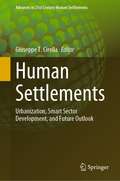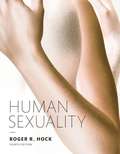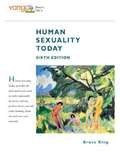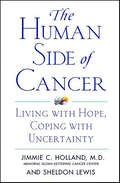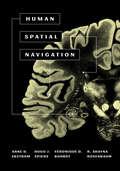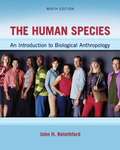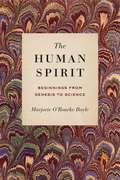- Table View
- List View
Human Resources in the Urban Economy (Routledge Revivals)
by Mark PerlmanDue to the urbanisation of American society and the economic problems that accompanied it; a series of conferences was held to explore the economics of human resources. Originally published in 1963, this study draws together papers from the first conference dealing mainly with the under-utilisation and misallocation of human resources, as well as wage rates, migration patterns and education in urban societies and the impact they have on the American labour force. This title will be of interest to students of Environmental Studies and Economics.
Human Respiratory Viral Infections
by Sunit SingUsing a multidisciplinary approach, Human Respiratory Viral Infections is set at the level between the definitive reference work and an essential clinical manual. Exploring recent advances in human respiratory viral research, the text builds on the basic sciences of epidemiology, virology, molecular biology, and immunology to cover clinical diagnosis, mechanism of pathogenesis, manifestations of disease, impact, treatment, and management strategies. <P><P> <li>Provides a comprehensive review of all the major human respiratory viral infections <li>Supplies a detailed description of the anatomy of the respiratory system <li>Discusses the salient features of specific viruses <li>Examines the latest diagnostic tools <li>Covers risk factors associated with incidence of respiratory viral infections in children and adults in different occupational and environmental settings <P><P>Presenting the latest knowledge in human respiratory viral infections, this text will be immensely valuable for pulmonologists, biomedical scientists, research scholars, virologists, vaccinologists, immunologists, clinicians, pharmacologists, and public health specialists.
Human Retrotransposons in Health and Disease
by Gael CristofariThis unique book explores the role of retrotransposons in human health and disease. The ability of retrotransposons to affect the structure of human genes is recognized since the late 80's. However, the advances of deep-sequencing technologies have shed new light on the extent of retrotransposon-mediated genome variations. These progresses have also led to the discovery that retrotransposon activity is not restricted to the germline - resulting in inheritable genetic variations - but can also mobilize in somatic tissues, such as embryonic stem cells, neuronal progenitor cells, or in many cancers. This book covers topics related to the effects of retrotransposon insertions, and their consequences on germline and somatic genome dynamics, but also discuss the role and impact of retrotransposons sequences in a broader context, including a number of novel topics that emerged recently (long non-coding RNA, neuronal disorders, exaptation) with unexpected connections between retrotransposons, stem cell maintenance, placentation, circadian cycles or aging.
Human Retrovirus Protocols
by Tuofu ZhuA cutting-edge collection of basic and state-of-the-art methods optimized for investigating the molecular biology of this class of retrovirus. These readily reproducible techniques range from methods for the isolation and detection of human retroviruses to cutting-edge methods for exploring the interplay between the viruses and the host. Here, the researcher will find up-to-date techniques for the isolation and propagation of HIV, HTLV, and foamy virus from a variety of sources. There are also assays for determining the cell tropism of HIV-1, the coreceptor usage of HIV-1, and human gene expression with HIV-1 infection by microarrays, as well as for phenotyping HIV-1 infected monocytes and examining their fitness. Highlights include the detection and quantification of HIV-1 in resting CD4+, a new cloning system for making recombinent virus, cDNA microarrays, and the determination of genetic polymorphisms in two recently identified HIV-1 co-factors that are critical for HIV-1 infection.
Human Retroviruses
by Elisa Vicenzi Guido Poli"Human Retroviruses: Methods and Protocols" collects key experimental protocols that have provided the basis of the major discoveries of the field. Split into five sections, this detailed volume covers mapping of the HIV life cycle, isolation, co-receptor use, and cell tropism of HIV-1, in vivo quantification of HIV-1, biological aspects of HIV-1, as well as HTLVs. Some articles explore assay and function of accessory genes, largely involving the interface between retroviral and host factors, the extracellular role of Tat and Tax, resembling the function of cytokines, and the biotechnological exploitation of HIV as lentiviral vector to carry foreign genes with therapeutic value. Written in the highly successful "Methods in Molecular Biology" series format, chapters include introductions to their respective topics, lists of the necessary materials and reagents, step-by-step, readily reproducible laboratory protocols, and tips on troubleshooting and avoiding known pitfalls. Comprehensive and authoritative, "Human Retroviruses: Methods and Protocols" provides state-of-art methodological protocols from world leaders in human retrovirology, essential for any lab working this vital field. "
Human Rights and Climate Change
by Siobhan Mcinerney-Lankford Mac Darrow Lavanya RajamaniThis Study explores arguments about the impact of climate change on human rights, examining the international legal frameworks governing human rights and climate change and identifying the relevant synergies and tensions between them. It considers arguments about (i) the human rights impacts of climate change at a macro level and how these impacts are spread disparately across countries; (ii) how climate change impacts human rights enjoyment within states and the equity and discrimination dimensions of those disparate impacts; and (iii) the role of international legal frameworks and mechanisms, including human rights instruments, particularly in the context of supporting developing countries' adaptation efforts. The Study surveys the interface of human rights and climate change from the perspective of public international law. It builds upon the work that has been carried out on this interface by reviewing the legal issues it raises and complementing existing analyses by providing a comprehensive legal overview of the area and a focus on obligations upon States and other actors connected with climate change. The objective has therefore been to contribute to the global debate on climate change and human rights by offering a review of the legal dimensions of this interface as well as a survey of the sources of public international law potentially relevant to climate change and human rights in order to facilitate an understanding of what is meant, in legal terms, by "human rights impacts of climate change" and help identify ways in which international law can respond to this interaction. This is a complex and dynamically evolving legal and policy landscape and this study aims to capture its most salient features insofar as they appear at present. The Study employs the following three-part conceptual understanding of the links between human rights and climate change. First, climate change may affect the enjoyment of human rights: this is explored in part II and draws from the existing work of the United Nations (UN) Office of the High Commissioner for Human Rights (OHCHR), the UN Human Rights Council and the International Council on Human Rights Policy. Second, measures to address climate change may impact the realization of human rights. This is a subset of the discussion of "impacts" targeting "secondary" human rights impacts of measures aimed at addressing climate change. Third, human rights have relevance to policy and operational responses to climate change, such that human rights obligations (both substantive and procedural) may be relevant to the design and implementation of effective responses to climate change, particularly in relation to adaptation and to some extent also to mitigation. Human rights may also have a role in promoting resilience to climate change and may reinforce sustainable development goals. The Study includes a number of approaches from connecting climate change to specific human rights impacts under international human rights law, to tracing the applicable sources of law and surveying identifiable obligations under international human rights law and international environmental law. The Study reviews how human rights law addresses environmental protection in substantive and procedural terms focusing in particular on the advances made in the latter through the jurisprudence of regional human rights bodies for example. The Study considers also how environmental protection has been extended to regulate private as well as public action. Following from this is a discussion of the application of human rights to climate change, including an outline of the various ways in which human rights can be seen to "add value" to the discourse, including the use of human rights legal framework as a tool for helping analyse climate impacts and determining appropriate policy responses. The Study includes a summary analysis of principles and precepts of international human rights law and multilateral environmental agreements (MEA) to consider their compatibility in conceptual terms. It concludes wi...
Human Rights and the Environment: Key Issues (Key Issues in Environment and Sustainability)
by Sumudu Atapattu Andrea SchapperThe field of human rights and the environment has grown phenomenally during the last few years and this textbook will be one of the first to encourage students to think critically about how many environmental issues lead to a violation of existing rights. Taking a socio-legal approach, this book will provide a good understanding of both human rights and environmental issues, as well as the limitations of each regime, and will explore the ways in which human rights law and institutions can be used to obtain relief for the victims of environmental degradation or of adverse effects of environmental policies. In addition, it will place an emphasis on climate change and climate policies to highlight the pros and cons of using a human rights framework and to underscore its importance in the context of climate change. As well as identifying emerging issues and areas for further research, each chapter will be rich in pedagogical features, including web links to further research and discussion questions for beyond the classroom. Combining their specialisms in law and politics, Atapattu and Schapper have developed a truly inter-disciplinary resource that will be essential for students of human rights, environmental studies, international law, international relations, politics, and philosophy.
The Human Rights-Based Approach to Carbon Finance
by Damilola S. OlawuyiThis book analyses the topical and contentious issue of the human rights impacts associated with carbon projects, especially in developing countries. It outlines a human rights-based approach to carbon finance as a functional framework for mainstreaming human rights into the design, approval, finance and implementation of carbon projects. It also describes the nature and scope of carbon projects, the available legal options for their financing and the key human rights issues at stake in their planning and execution. Written in a user-friendly style, the proposal for a rights-based due diligence framework through which human rights issues can be anticipated and addressed makes this book relevant to all stakeholders in carbon, energy, and environmental investments and projects.
Human Rights Redefining Legal Thought: The History of Human Rights Discourse in Finnish Legal Scholarship (Studies in the History of Law and Justice #16)
by Juhana Mikael SalojärviThis book investigates the origins and development of human rights discourse in Finnish legal scholarship in the twentieth century. It provides a detailed account of how human rights were understood before they had legal relevance in a positivist sense, how they were adapted to Finnish legal thinking in the post-Second World War decades, how they developed into a mode of legal rhetoric and a type of legal argument during the 1970s and 1980s, and how they eventually became a significant paradigm in legal thinking in the 1990s. The book also demonstrates how rights discourse infiltrated the discussion regarding problems that were previously addressed in arguments concerning morals, social justice and equity. Although the book focuses on the history of Finnish legal scholarship, it is also interesting from a global perspective for two reasons: Firstly, it demonstrates how an idea of international law is transplanted and diffused into national legal thinking; Finland is an illustrative example in this regard. Secondly, it offers insights into the general history of human rights.
Human Ring Chromosomes: A Practical Guide for Clinicians and Families
by Peining Li Thomas LiehrThis book presents chromosome-wise clinical cases following an evidence-based protocol, in addition to providing the scientific background on the mechanisms of human ring chromosome (RC) formation. Presence of RCs in a genome can lead to several rare genetic diseases. This book, edited by the leading experts Prof. Peining Li and Prof. Thomas Liehr, is the first comprehensive book on this topic.Over the past 60 years, banding cytogenetics, fluorescence in situ hybridization, chromosome microarray analysis, and whole genome sequencing have been used to diagnose cases with a RC. Ring syndrome of sever growth retardation and variable intellectual disability has been considered a common clinical feature for all RCs. Clinical heterogeneity of chromosome-specific deletion and duplication syndromes, gene-related organ and tissue defects, cancer predisposition to different types of tumors, and reproduction failure has been reported in the literature. However, the cases of RCs reportedin the literature account for less than 1% of its real occurrence. Current diagnostic practice lacks laboratory standards for analyzing cellular behavior and genomic imbalances of RCs to evaluate its compound effects on patients. The under-representation of clinical cases and the lack of comprehensive diagnostic analysis make challenging to establish accurate clinico-cytogenomic correlations. Given recent advances in genomic technology and organized efforts from peer experts, standardized cytogenomic diagnosis and evidence-based clinical management could be envisioned for all patients with RCs.Furthermore, supernumerary small ring chromosomes and the patient’s perspective are addressed—the latter by including family stories of RC-carrier relatives. Acquired RCs in various cancers are also discussed, as well as the potential role of RCs in research applications like iPSC cellular modeling and genomic editing.This book is a valuable reference for clinical geneticists, personnel in cytogenetics and molecular genetics laboratories, genetic counselors, and researchers in related fields.
Human Risk Assessment: The Role Of Animal Selection And Extrapolation
by M. V. Roloff; A. G. E. Wilson; W. E. Ribelin; W. P. Ridley; F. A. RueckerThis book explores the factors which are critical in the selection of an appropriate animal species for toxicology studies and the subsequent extrapolation of the data to humans. It provides some future directions for risk assessment activities at the Environmental Protection Agency.
Human-Robot Interaction: Evaluation Methods and Their Standardization (Springer Series on Bio- and Neurosystems #12)
by Céline Jost Brigitte Le Pévédic Tony Belpaeme Cindy Bethel Dimitrios Chrysostomou Nigel Crook Marine Grandgeorge Nicole MirnigThis book offers the first comprehensive yet critical overview of methods used to evaluate interaction between humans and social robots. It reviews commonly used evaluation methods, and shows that they are not always suitable for this purpose. Using representative case studies, the book identifies good and bad practices for evaluating human-robot interactions and proposes new standardized processes as well as recommendations, carefully developed on the basis of intensive discussions between specialists in various HRI-related disciplines, e.g. psychology, ethology, ergonomics, sociology, ethnography, robotics, and computer science. The book is the result of a close, long-standing collaboration between the editors and the invited contributors, including, but not limited to, their inspiring discussions at the workshop on Evaluation Methods Standardization for Human-Robot Interaction (EMSHRI), which have been organized yearly since 2015. By highlighting and weighing good and bad practices in evaluation design for HRI, the book will stimulate the scientific community to search for better solutions, take advantages of interdisciplinary collaborations, and encourage the development of new standards to accommodate the growing presence of robots in the day-to-day and social lives of human beings.
Human-Robot Interactions in Future Military Operations (Human Factors in Defence)
by Florian JentschSoldier-robot teams will be an important component of future battle spaces, creating a complex but potentially more survivable and effective combat force. The complexity of the battlefield of the future presents its own problems. The variety of robotic systems and the almost infinite number of possible military missions create a dilemma for researchers who wish to predict human-robot interactions (HRI) performance in future environments. Human-Robot Interactions in Future Military Operations provides an opportunity for scientists investigating military issues related to HRI to present their results cohesively within a single volume. The issues range from operators interacting with small ground robots and aerial vehicles to supervising large, near-autonomous vehicles capable of intelligent battlefield behaviors. The ability of the human to 'team' with intelligent unmanned systems in such environments is the focus of the volume. As such, chapters are written by recognized leaders within their disciplines and they discuss their research in the context of a broad-based approach. Therefore the book allows researchers from differing disciplines to be brought up to date on both theoretical and methodological issues surrounding human-robot interaction in military environments. The overall objective of this volume is to illuminate the challenges and potential solutions for military HRI through discussion of the many approaches that have been utilized in order to converge on a better understanding of this relatively complex concept. It should be noted that many of these issues will generalize to civilian applications as robotic technology matures. An important outcome is the focus on developing general human-robot teaming principles and guidelines to help both the human factors design and training community develop a better understanding of this nascent but revolutionary technology. Much of the research within the book is based on the Human Research and Engineering Directorate (HRED), U.S. Army Research Laboratory (ARL) 5-year Army Technology Objective (ATO) research program. The program addressed HRI and teaming for both aerial and ground robotic assets in conjunction with the U.S. Army Tank and Automotive Research and Development Center (TARDEC) and the Aviation and Missile Development Center (AMRDEC) The purpose of the program was to understand HRI issues in order to develop and evaluate technologies to improve HRI battlefield performance for Future Combat Systems (FCS). The work within this volume goes beyond the research results to encapsulate the ATO's findings and discuss them in a broader context in order to understand both their military and civilian implications. For this reason, scientists conducting related research have contributed additional chapters to widen the scope of the original research boundaries.
The Human Scaffold: How Not to Design Your Way Out of a Climate Crisis (Great Transformations #2)
by Josh BersonHumanity has precipitated a planetary crisis of resource consumption—a crisis of stuff. So ingrained is our stuff-centric view that we can barely imagine a way out beyond substituting a new portmanteau of material things for the one we have today.In The Human Scaffold, anthropologist Josh Berson offers a new theory of adaptation to environmental change. Drawing on niche construction, evolutionary game theory, and the enactive view of cognition, Berson considers cases in the archaeology of adaptation in which technology in the conventional sense was virtually absent. Far from representing anomalies, these cases exemplify an enduring feature of human behavior that has implications for our own fate.The time has come to ask what the environmental crisis demands of us not as consumers but as biological beings. The Human Scaffold offers a starting point.
Human Scent Evidence (Forensic Science Techniques Ser.)
by Paola A. Prada Allison M. Curran Kenneth G. FurtonDuring the last decade, scientific studies have supported using human scent as a biometric tool and indicator of the presence or absence of an individual at a crime scene. This book focuses on some of these recent advances in the use of human scent as forensic evidence. It examines theories of human odor production, the legal significance of results, and canine scent work from multiple search categories as described in the Scientific Working Group on Dog and Orthogonal detector Guidelines (SWGDOG). It also explores current trends in scent collection techniques, including devices, materials, and storage protocols.
Human Settlements: Urbanization, Smart Sector Development, and Future Outlook (Advances in 21st Century Human Settlements)
by Giuseppe T. CirellaThe answers to the questions of why and how people live where they live as well as how they maintain and integrate with one another are fundamental human settlement issues rooted in history and culture. Human settlements are historically linked to resource availability, fortification, and the mythos of civilizations. Cities play a central role in redefining the interface between human beings and nature. They have revolutionized the human experience by taming natural surroundings and building environments that are human-centric—often narrowing human life outside the experience of wilderness or the untamed. This book is divided into three parts, it examines urban development trends, explores perspectives in energy efficiency and agriculture security, and considers policy development and future scenarios in human-nature relations. It is a compendium of multidisciplinary work that challenges the directions of modernity and offers reference to alternatives. Authors come from a diverse background and international context to address common overarching theories facing current geography-specific problems. An interconnected overtone of the book attempts to link accelerated urbanization and settlement location to how societies are maintained and integrated. Human settlements are shaped by human ecology and the relationship between humans and their interaction with their environment. Two sectors central to human survival are specifically explored: energy and agriculture. Cutting-edge, smart development looks at the latest findings that reflect the on-going debate facing these sectors. A human settlement metric is envisioned in terms of the past, present, and future. This book is a unique attempt to combine a rethinking about human settlements for scientists, policy-makers, public officials, and people committed to improving urban life, society-wide. Possible agents to resolving human settlement problems include international cooperation and various mechanisms that interlace the international community. Methodological and applied aspects of sustainable management focus on topics such as adaptive knowledge sharing, renewable energy, climate change, agricultural planning, and policy development. An emphasis on scientific and technological advancement, from a bottom-up mapping of society, elucidates a better understanding of the role of knowledgeable societies in which need is considered alongside how such need can be sustained—advancing towards a more promising future.
Human Sexuality
by Roger R. HockHelp each student develop a sexual philosophy based on choice, awareness, and responsibility Human Sexuality presents a relatable overview of the discipline that inspires students to think critically about the sexual world and their place in it. By taking an interpersonal approach and encouraging each student to develop a personal sexual philosophy, author Roger Hock helps students connect the material covered to their real-life decisions and behaviors, boosting engagement with the course. Sensitivity to diverse groups – not only in terms of race and ethnicity, but also in terms of sexual orientation, age, sexual knowledge, and sexual experience – allows all students to feel as comfortable and open about sexual topics as possible. The Fourth Edition includes updated data as well as coverage of contemporary issues that dominate today's headlines to ensure currency and relevancy.
Human Sexuality: Making Informed Decisions
by David Knox Mark A Whatley Caroline SchachtProvides an understanding of the human reproductive system, the various factors that influence the sexual decisions that every individual make and guides us to making the right sexual decision putting into consideration all the outcomes/consequences of every option. The book lets us know we have a deliberate choice to make in a relationship, a healthy choice for both the body and mind.
Human Sexuality Today (6th Edition)
by Bruce M. KingThe sixth edition of Human Sexuality Today provides students with the information they need to make responsible decisions and helps them feel comfortable about themselves while learning about their sexuality.
The Human Side of Cancer: Living with Hope, Coping with Uncertainty
by Sheldon Lewis Jimmie C. HollandFor more than twenty years, Dr. Holland has pioneered the study of psychological problems of cancer patients and their families -- whom she calls "the real experts." In The Human Side of Cancer, she shares what she has learned from all of them about facing this life-threatening illness and what truly helps along the cancer journey. This book is the next best thing to sitting in Dr. Holland's office and talking with her about the uncertainty and anxiety elicited by this disease. And it is a book that inspires hope -- through stories of the simple courage of ordinary people confronting cancer.
Human Space Exploration (World Book's Solar System and Space Exploration Library)
by Karen Ingebretsen"Introduction to space exploration, providing to primary and intermediate grade students information on astronauts, space shuttles, and space stations. Includes fun facts, glossary, resource list and index."--Provided by publisher.
Human Spatial Navigation
by Arne D. Ekstrom Hugo J. Spiers Véronique D. Bohbot R. Shayna RosenbaumThe first book to comprehensively explore the cognitive foundations of human spatial navigationHumans possess a range of navigation and orientation abilities, from the ordinary to the extraordinary. All of us must move from one location to the next, following habitual routes and avoiding getting lost. While there is more to learn about how the brain underlies our ability to navigate, neuroscience and psychology have begun to converge on some important answers. In Human Spatial Navigation, four leading expertstackle fundamental and unique issues to produce the first book-length investigation into this subject. Opening with the vivid story of Puluwat sailors who navigate in the open ocean with no mechanical aids, the authors begin by dissecting the behavioral basis of human spatial navigation. They then focus on its neural basis, describing neural recordings, brain imaging experiments, and patient studies. Recent advances give unprecedented insights into what is known about the cognitive map and the neural systems that facilitate navigation. The authors discuss how aging and diseases can impede navigation, and they introduce cutting-edge network models that show how the brain can act as a highly integrated system underlying spatial navigation. Throughout, the authors touch on fascinating examples of able navigators, from the Inuit of northern Canada to London taxi drivers, and they provide a critical lens into previous navigation research, which has primarily focused on other species, such as rodents. An ideal book for students and researchers seeking an accessible introduction to this important topic, Human Spatial Navigation offers a rich look into spatial memory and the neuroscientific foundations for how we make our way in the world.
Human Species: An Introduction to Biological Anthropology Ninth Edition
by John RelethfordIn its ninth edition, The Human Species continues to provide a comprehensive approach to biological anthropology, especially the relationship between biology and culture, behavior in an evolutionary context, and humans as a species within the primate order. With its lively narrative and emphasis on the most current topics and findings in the field, The Human Species explores the major questions that concern biological anthropologists about our species.
The Human Spirit: Beginnings from Genesis to Science
by Marjorie O’Rourke BoyleIn this volume, Marjorie O’Rourke Boyle probes significant concepts of the human spirit in Western religious culture across more than two millennia, from the book of Genesis to early modern science. The Human Spirit treats significant interpretations of human nature as religious in political, philosophical, and physical aspects by tracing its historical subject through the Priestly tradition of the Hebrew Bible and the writings of the apostle Paul among the Corinthians, the innovative theologians Augustine and Aquinas, the reformatory theologian Calvin, and the natural philosopher and physician William Harvey. Boyle analyzes the particular experiences and notions of these influential authors while she contextualizes them in community. She shows how they shared a conviction, although distinctly understood, of the human spirit as endowed by or designed by a divine source of everything animate.An original and erudite work that utilizes a rich and varied array of primary source material, this volume will be of interest to intellectual and cultural historians of religion, philosophy, literature, and medicine.
The Human Spirit: Beginnings from Genesis to Science
by Marjorie O’Rourke BoyleIn this volume, Marjorie O’Rourke Boyle probes significant concepts of the human spirit in Western religious culture across more than two millennia, from the book of Genesis to early modern science. The Human Spirit treats significant interpretations of human nature as religious in political, philosophical, and physical aspects by tracing its historical subject through the Priestly tradition of the Hebrew Bible and the writings of the apostle Paul among the Corinthians, the innovative theologians Augustine and Aquinas, the reformatory theologian Calvin, and the natural philosopher and physician William Harvey. Boyle analyzes the particular experiences and notions of these influential authors while she contextualizes them in community. She shows how they shared a conviction, although distinctly understood, of the human spirit as endowed by or designed by a divine source of everything animate.An original and erudite work that utilizes a rich and varied array of primary source material, this volume will be of interest to intellectual and cultural historians of religion, philosophy, literature, and medicine.
